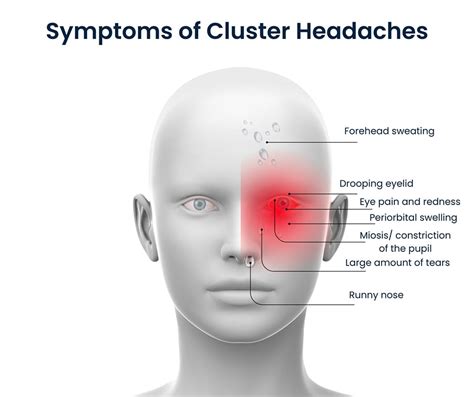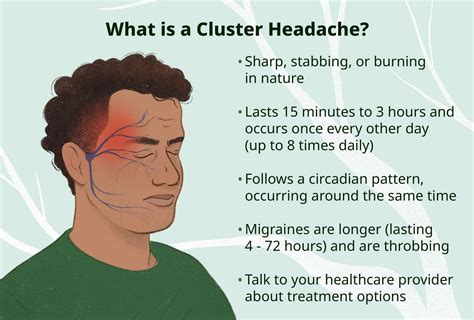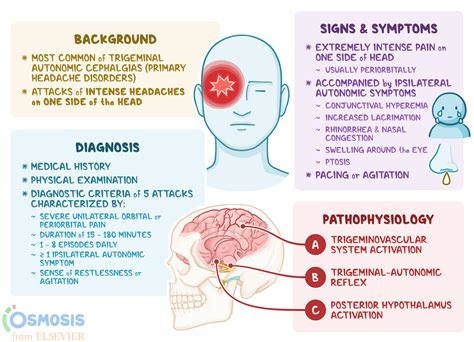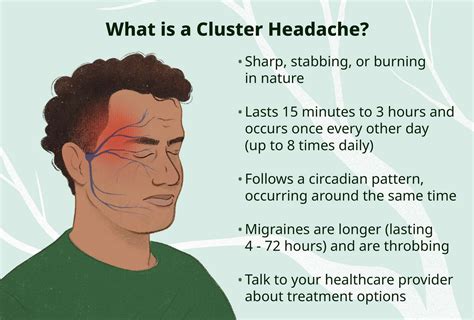Intro
Headaches are a common health issue that can affect anyone, regardless of age, gender, or lifestyle. While most headaches are not a cause for concern and can be treated with over-the-counter medication, some types of headaches can be a symptom of a more serious underlying condition. One such type of headache is a cluster headache, which is a severe and debilitating condition that can have a significant impact on a person's quality of life. Cluster headaches are a type of headache disorder that is characterized by recurring episodes of severe headaches, often accompanied by other symptoms such as eye pain, nasal congestion, and sensitivity to light and sound.
Cluster headaches are relatively rare, affecting only about 1 in 1,000 people, but they can be extremely painful and disruptive to daily life. The exact cause of cluster headaches is not fully understood, but research suggests that they may be related to abnormalities in the brain's blood vessels and nerve pathways. During a cluster headache episode, the blood vessels in the brain become inflamed, leading to a significant increase in blood flow and pressure, which can cause the characteristic pain and other symptoms. Understanding the causes and mechanisms of cluster headaches is crucial for developing effective treatments and management strategies.
The symptoms of cluster headaches can vary from person to person, but they often include severe, piercing, or burning pain on one side of the head, typically around the eye or temple. The pain can be so severe that it wakes people up from sleep, and it can be accompanied by other symptoms such as eye watering, nasal congestion, and sensitivity to light and sound. Cluster headaches can also cause restlessness, agitation, and a sense of urgency, which can make it difficult for people to stay still or relax during an episode. The frequency and duration of cluster headache episodes can vary, but they often occur in clusters or cycles, with periods of remission in between.
Causes and Risk Factors

The exact causes of cluster headaches are not fully understood, but research suggests that they may be related to a combination of genetic, environmental, and lifestyle factors. Some potential risk factors for cluster headaches include a family history of the condition, as well as certain lifestyle factors such as smoking, heavy drinking, and lack of sleep. Additionally, some people may be more susceptible to cluster headaches due to underlying medical conditions such as high blood pressure, diabetes, or thyroid disorders. Understanding the causes and risk factors of cluster headaches is crucial for developing effective prevention and treatment strategies.
Genetic Factors
Genetic factors are thought to play a significant role in the development of cluster headaches, with some studies suggesting that people with a family history of the condition are more likely to experience cluster headaches themselves. While the exact genetic mechanisms are not fully understood, research suggests that cluster headaches may be related to abnormalities in certain genes that regulate blood vessel function and pain perception.Environmental Factors
Environmental factors, such as lifestyle and diet, may also play a role in the development of cluster headaches. Some potential triggers for cluster headaches include certain foods, such as citrus fruits, chocolate, and fermented foods, as well as lifestyle factors such as stress, lack of sleep, and heavy drinking. Additionally, some people may be more susceptible to cluster headaches due to underlying medical conditions such as allergies, sinusitis, or dental problems.Symptoms and Diagnosis

The symptoms of cluster headaches can vary from person to person, but they often include severe, piercing, or burning pain on one side of the head, typically around the eye or temple. The pain can be so severe that it wakes people up from sleep, and it can be accompanied by other symptoms such as eye watering, nasal congestion, and sensitivity to light and sound. Cluster headaches can also cause restlessness, agitation, and a sense of urgency, which can make it difficult for people to stay still or relax during an episode.
Diagnostic Criteria
The diagnostic criteria for cluster headaches include a combination of clinical features, such as the characteristic pain and other symptoms, as well as the frequency and duration of episodes. A diagnosis of cluster headaches is typically made based on a thorough medical history, physical examination, and laboratory tests to rule out other potential causes of the symptoms.Differential Diagnosis
The differential diagnosis for cluster headaches includes other types of headache disorders, such as migraines, tension headaches, and trigeminal neuralgia, as well as other medical conditions that can cause similar symptoms, such as sinusitis, dental problems, and eye disorders. A thorough medical evaluation is necessary to rule out other potential causes of the symptoms and to confirm a diagnosis of cluster headaches.Treatment and Management

The treatment and management of cluster headaches typically involve a combination of pharmacological and non-pharmacological strategies. Medications such as triptans, ergots, and corticosteroids may be used to relieve acute symptoms, while preventive medications such as verapamil, lithium, and topiramate may be used to reduce the frequency and severity of episodes.
Acute Treatment
The acute treatment of cluster headaches typically involves the use of medications such as triptans, ergots, and corticosteroids to relieve pain and other symptoms. Oxygen therapy may also be used to help relieve symptoms, particularly during severe episodes.Preventive Treatment
The preventive treatment of cluster headaches typically involves the use of medications such as verapamil, lithium, and topiramate to reduce the frequency and severity of episodes. Lifestyle modifications, such as avoiding triggers, maintaining a regular sleep schedule, and practicing stress-reducing techniques, may also be recommended to help manage symptoms.Lifestyle Modifications

Lifestyle modifications can play an important role in managing cluster headaches, particularly in reducing the frequency and severity of episodes. Some potential lifestyle modifications that may be recommended include avoiding triggers, maintaining a regular sleep schedule, and practicing stress-reducing techniques such as meditation, yoga, or deep breathing exercises.
Trigger Avoidance
Avoiding triggers is an important part of managing cluster headaches, particularly for people who experience frequent or severe episodes. Some potential triggers that may need to be avoided include certain foods, such as citrus fruits, chocolate, and fermented foods, as well as lifestyle factors such as stress, lack of sleep, and heavy drinking.Stress Management
Stress management is an important part of managing cluster headaches, particularly for people who experience frequent or severe episodes. Stress-reducing techniques such as meditation, yoga, or deep breathing exercises may be recommended to help manage symptoms and reduce the frequency and severity of episodes.Alternative Therapies

Alternative therapies, such as acupuncture, massage, and chiropractic care, may be used to help manage cluster headaches, particularly for people who experience frequent or severe episodes. These therapies may be used in conjunction with pharmacological and lifestyle modifications to help relieve symptoms and improve quality of life.
Acupuncture
Acupuncture is a form of traditional Chinese medicine that involves the insertion of thin needles into specific points on the body to stimulate healing and relieve symptoms. Some studies suggest that acupuncture may be effective in reducing the frequency and severity of cluster headache episodes.Massage Therapy
Massage therapy is a form of manual therapy that involves the manipulation of soft tissue to relieve pain and promote relaxation. Some studies suggest that massage therapy may be effective in reducing the frequency and severity of cluster headache episodes, particularly when used in conjunction with other treatments.What are the symptoms of cluster headaches?
+Cluster headaches are characterized by severe, piercing, or burning pain on one side of the head, typically around the eye or temple, as well as other symptoms such as eye watering, nasal congestion, and sensitivity to light and sound.
How are cluster headaches diagnosed?
+A diagnosis of cluster headaches is typically made based on a thorough medical history, physical examination, and laboratory tests to rule out other potential causes of the symptoms.
What are the treatment options for cluster headaches?
+The treatment and management of cluster headaches typically involve a combination of pharmacological and non-pharmacological strategies, including medications, lifestyle modifications, and alternative therapies.
We hope this article has provided you with a comprehensive understanding of cluster headaches, including their causes, symptoms, diagnosis, treatment, and management. If you have any further questions or would like to share your experiences with cluster headaches, please feel free to comment below. Additionally, if you found this article helpful, please consider sharing it with others who may be affected by this condition. By working together, we can raise awareness and promote better understanding and management of cluster headaches.
